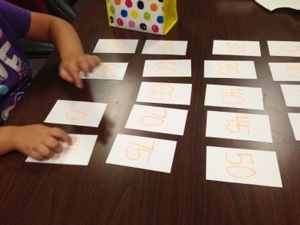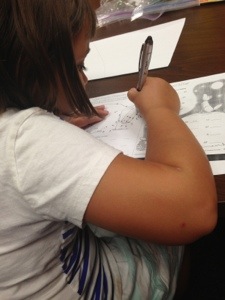For a lot of students, and many adults, one subject comes more easily to you than another. You’re either a “math person” or a “reading person”. I would be the first to raise my hand as a member of the “reading person” group, but as a teacher, I’ve come to view myself more and more in a mathematical perspective. We want our students to see themselves as capable of anything – they are writers, readers, scientists, explorers, artists, athletes, and yes – mathematicians.
In my very first blog post, I wrote about all the different types of literacy. In schools today, so much emphasis is placed on reading and math. Being mathematically literate is just as complex as being functionally literate and able to read. There are several components. Below is a graphic from www.math4teaching.com. This website is an awesome resource for teachers and parents alike.
In Kindergarten, we fortify the foundation for mathematical literacy. Our students come in with a sense of what numbers are and the meaning numbers have in their lives. Every brick we add to this foundation is hopefully equipping our students to be mathematicians in upper grades.
During my tutoring sessions this summer, we have been working a lot with numeracy and quantitative literacy. We are focusing on the order of numbers and how we can change a number by adjusting the value we give that number. The numeral nine can have multiple meanings, depending on the value you give it. Is it 9, 90, or 900? As a former teacher of upper grades, many of my struggling students lacked a true understanding of the value of numbers. When a student does not have a strong foundational understanding of number sense and place value, this can cause issues with more difficult math later on – multiplying, dividing, fractions. Number sense is key.
As always, I use several different methods during one hour long tutor session. We use games, handouts, the iPad, etc. Again – varying the approach makes tutoring more fun and insures the student will hear the same concept multiple times (without getting bored).
 The app Pocket Charts Pro is pretty amazing. It incorporates both reading and math into one app. There are 20 different “pocket charts” for the students to choose from. In this picture, the student is using the Counting 1-20 pocket chart. As you can see, a star is awarded when the student matches correctly. When a student uses guessing as a strategy (crutch), they can just keep putting numbers up until they get the star. While working with this student, I am reminding her that guessing is actually taking her more time (for the most part) than if she just counted as matched appropriately. This is another reason why I use different methods and modes of learning during tutoring – I’m trying to weed out the strategies that are more crutches than actual strategies. Can guessing be beneficial at times? Of course! But in this case, I need to SEE that she understands the value of the numbers and can match using 1:1 correspondence.
The app Pocket Charts Pro is pretty amazing. It incorporates both reading and math into one app. There are 20 different “pocket charts” for the students to choose from. In this picture, the student is using the Counting 1-20 pocket chart. As you can see, a star is awarded when the student matches correctly. When a student uses guessing as a strategy (crutch), they can just keep putting numbers up until they get the star. While working with this student, I am reminding her that guessing is actually taking her more time (for the most part) than if she just counted as matched appropriately. This is another reason why I use different methods and modes of learning during tutoring – I’m trying to weed out the strategies that are more crutches than actual strategies. Can guessing be beneficial at times? Of course! But in this case, I need to SEE that she understands the value of the numbers and can match using 1:1 correspondence.
 We are also reviewing counting by 1’s, 5’s, and 10’s. We chant, write, and match. We fill in missing numbers in grids and on number lines. We place cards in order as shown in this picture. Skip counting can come across as a very “rote” activity. However, it lays the foundation for a great strategy students can use when adding, subtracting, multiplying, and dividing. The ability to manipulate a number grid/line adds to the numeracy aspect of mathematical literacy.
We are also reviewing counting by 1’s, 5’s, and 10’s. We chant, write, and match. We fill in missing numbers in grids and on number lines. We place cards in order as shown in this picture. Skip counting can come across as a very “rote” activity. However, it lays the foundation for a great strategy students can use when adding, subtracting, multiplying, and dividing. The ability to manipulate a number grid/line adds to the numeracy aspect of mathematical literacy.
 My school is fortunate enough to have 1:1 iPads in each and every classroom. However, I understand the importance of still being able to put pencil to paper. A student may transfer to another school where iPads are not readily available. Again this is a case of multiple deliveries and methods – showing literacy in a variety of ways. Here, the student is connecting the dots through skip counting. She then fills in missing numbers – before and after. We follow up by playing hopscotch outside with numbers (similar to the sight word hopscotch) and guess my number.
My school is fortunate enough to have 1:1 iPads in each and every classroom. However, I understand the importance of still being able to put pencil to paper. A student may transfer to another school where iPads are not readily available. Again this is a case of multiple deliveries and methods – showing literacy in a variety of ways. Here, the student is connecting the dots through skip counting. She then fills in missing numbers – before and after. We follow up by playing hopscotch outside with numbers (similar to the sight word hopscotch) and guess my number.
One of my favorite things to do – and the students seemed to enjoy as well – was telling number stories. I would tell a number story using the students’ names. They would use mental math or their fingers to solve. We would “erase our hands” (shake them out) after each story.
Also – just because I love incorporating books into every subject area – here is a link to one of my favorite informational authors – Loreen Leedy! http://www.loreenleedy.com/books/booktitles.html


